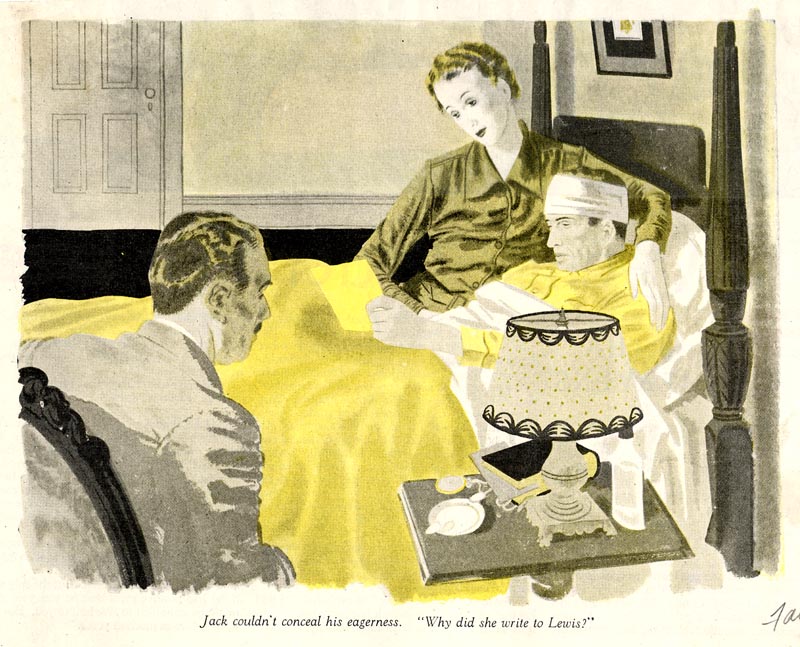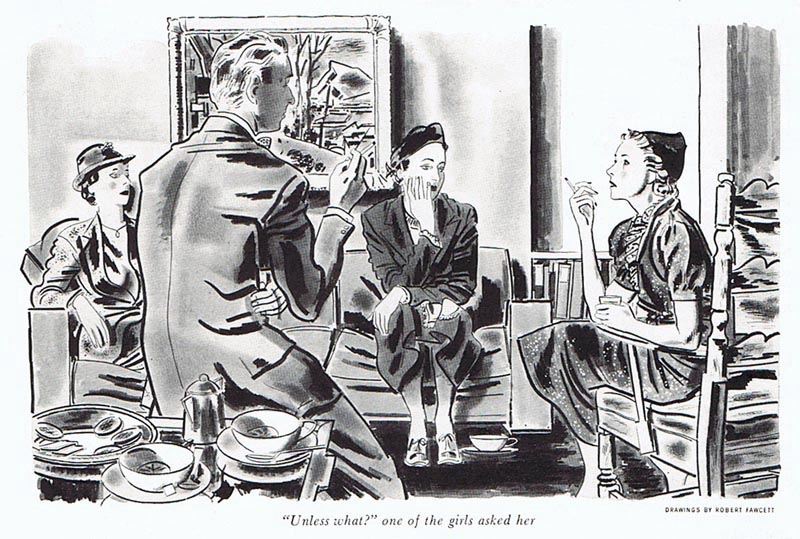
"I have studies accurate drawing enough in the past so that it should be starting to pay off now."

"Besides, when one invents, one is free to design. When I am faced with models it is too easy to get the drawing cluttered up with a lot of natural but irrelevant embroidery, such as accidental wrinkles and lighting, all of which detracts from the story."

"I would like to be able to sell illustrations having the directness and economy of the best humorous drawings in the New Yorker."

- Robert Fawcett in a 1946 interview for American Artist magazine
* My Robert Fawcett Flickr set.
* Many thanks to Chuck Pyle who provided 3 of the 4 scans in this post.
* There is a show of 25 Robert Fawcett originals opening on Saturday, May 22nd at Gallery Nucleus in Alhambra, CA.
*ALSO* Robin Richesson sent a note to let us know that she has posted a nice large scan on her blog of a Robert Fawcett original she recently purchased - thanks Robin!
These are brilliant in their mediocrity.You can see the essence of Fawcett here but it is minus the incredible draughtsmanship he developed later.
ReplyDeleteTo know that a stellar talent could produce this level of work gives hope to us all.Thanks Leif.
"Brilliant in their mediocrity" is now my new favourite expression, Chad - many thanks! ;^)
ReplyDeleteNo.Thanks to you,Leif.I'm just amazed how Fawcett went back on nearly everything he said in this interview in the pursuit of his development.
ReplyDeleteDidn't need 'a high degree of lifelike accuracy'? That changed.
Doesn't draw from models or render every wrinkle? That changed.
Directness and economy like a humorous drawing from the New Yorker? That never happened.
You've excelled yourself on this one Leif.Fawcett must have gone through some kind of unbelievable self-appraisal soon after.But I can believe that of him.
It occurred to me while reading Chad's comments, that Fawcett may have simply been responding to his apparently contrary personality. If the flavors of the moment was loose, spontaneous, simplified, stylized, design oriented illustrations, he would do tight, detailed, academic, literal illustrations.. and for the most part, that is exactly what he did through the 50's and into the 60's. And, seemed to stay pretty busy, in spite of the radical acceleration of new flavors to choose from. And, thanks for the "new flavor" analogy Chad.. it's now my favorite expression. ;-)
ReplyDeleteTom Watson
Leif, I am really struck by how weak some of these early efforts by Fawcett were. (I am also struck that someone would bother to preserve tearsheets of such work unless they sensed Fawcett would one day become a genius). The upcoming book about Fawcett will show some of his work from art school in 1922 when he was 19 years old, and it will knock your socks off. His work was astonishingly perceptive and accomplished and mature back then, and his comments from his professors showed that they recognized it.
ReplyDeleteWhat the heck happened here? I am guessing the main problem was that Fawcett never studied painting at all. He studied drawing intensely, and in his arrogance assumed that when a painting assignment came in, he could pick up the necessary skills quickly. Obviously he was wrong.
It's a little bit like Berni Wrightson who did accomplished drawings in pen and ink, then one day decided he wanted to apply those skills to painting and ended up creating the most leaden, ungainly paintings you can imagine. (Only at least Berni Wrightson wasn't color blind, like Fawcett).
Ultimately, Fawcett developed his own technique for painting that was far better suited to his personal skills-- he drew whatever he wanted in ink and then covered it with layers of dyes and water colors. It's a good thing, too. These are pretty bad.
David; I think its excellent to see work like this by Fawcett, if only as a historical curiosity. But even more so, its kind of reassuring, as Chad said, to know even a Robert Fawcett began at a human level and had to work and grow to become a superhuman!
ReplyDeleteIt means there's hope (albeit faint) for us mere mortals!
"Didn't need 'a high degree of lifelike accuracy'? That changed."
ReplyDeleteNot necessarily, Fawcett approached lifelike resemblance in a thoughtful manner. He was never a slave to a model. The last image is a huge indicator of what his style would soon become, other than the loss of color. While I agree these examples are not on par with his award winning work, they do show small and relentless gleams of brilliance.
"Doesn't draw from models or render every wrinkle? That changed."
I don't believe he ever became a slave to his model. As you can see in these early attempts, his natural sense of design was starting to manifest itself. Take for example the startling brutal ink attacks of his starting roughs in "The Art of Drawing".
"Directness and economy like a humorous drawing from the New Yorker? That never happened."
Robert Fawcett was said to have a major respect for line cartoonists. Also, a yearning to draw like one. Alex Toth said in an interview that he attended lectures by Fawcett. At a particular meeting, he had a large chalk board in the front. It was covered with a large piece of cloth. At the end of the class he tore the cloth down furiously, under it was a large reproduction of a Pete Arno New Yorker cartoon. Fawcett then exclaimed to the class "I will not rest till I can draw this simply." I believe that while Fawcett was an exquisite draftsmen, he also should be commended for his keen imagination. "The Art of Drawing" expounds his earnest disposition toward the importance of imagination. People are easily blinded by beautiful drawn cloth.
Thank you Leif for you incredible blog. I hope your not unaware of the profound effect your posts have on many, day to day.
Thank you Nikolas - for your kind words and for providing so much interesting counterpoint! One thing I found quite appealing about these early Fawcetts relates to the quote I chose for the post heading -- though they are far from the masterpieces Fawcett would do later on, they are all well designed. As he said, he wanted to be free to do so and not be distracted by slavishly copying 'reality' - even at this early stage in his career, he accomplishes this goal. Interesting, in light of your comment, to note that strong picture design was Toth's priority as well.
ReplyDelete